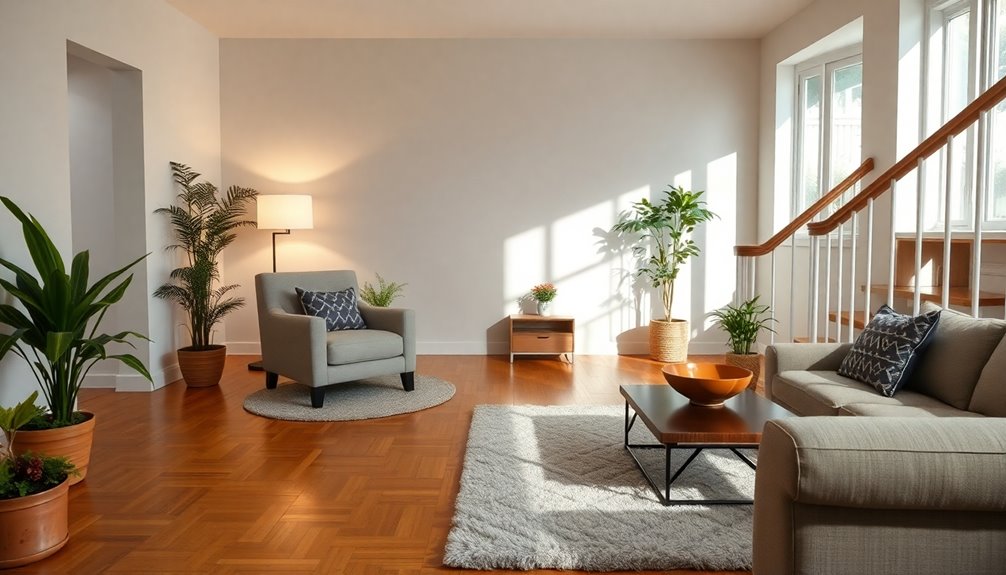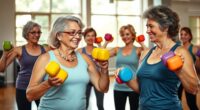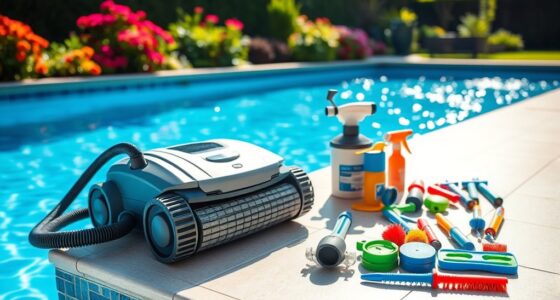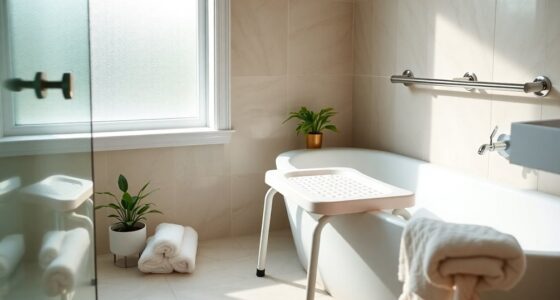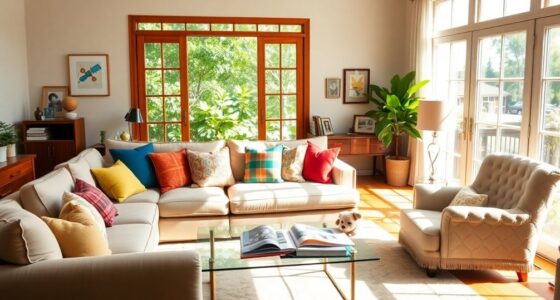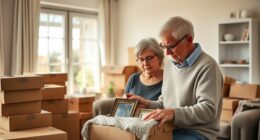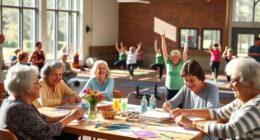To reduce the risk of falls at home, make an appointment with your healthcare provider to discuss your health. Keep moving with regular exercise and wear sensible shoes with non-slip soles. Remove home hazards by clearing clutter and ensuring good lighting throughout your space. Use assistive devices like canes if needed. Manage your health by monitoring chronic conditions and reviewing medications. For more strategies to enhance your safety, there's plenty more to explore.
Key Takeaways
- Clear walkways of clutter to minimize tripping hazards and maintain a clean environment.
- Ensure all living spaces are well-lit, particularly hallways and stairways, to improve visibility.
- Wear sensible, non-slip footwear that fits well to enhance balance and stability.
- Install handrails and grab bars in bathrooms and on stairways for added support.
- Conduct regular health check-ups to assess medications and chronic conditions that may increase fall risk.
Make an Appointment With Your Health Care Provider
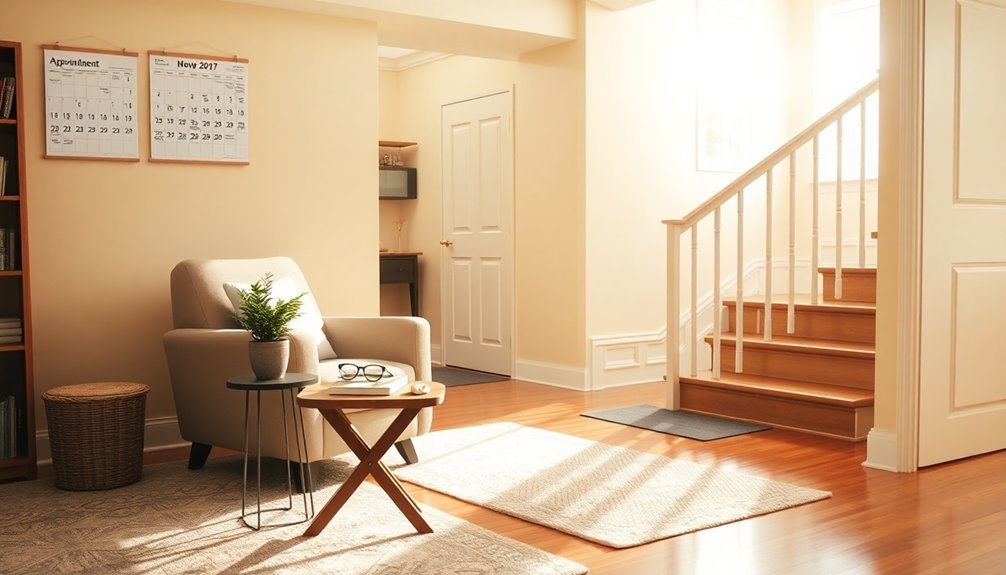
When you prioritize your health by making an appointment with your health care provider, you take an essential step in reducing your fall risk at home.
During your visit, it's vital to review your medications for any side effects or interactions that could increase your fall risk. Discussing personalized fall prevention strategies helps you develop tailored approaches to address your specific needs.
Be sure to talk about any previous falls or near-falls, as this information allows your provider to assess your fall risk accurately. Additionally, having your balance, muscle strength, and walking style evaluated can highlight health conditions that may require attention.
Regular check-ups help monitor balance issues and guarantee you receive appropriate treatments, further minimizing your risk of falls.
Keep Moving
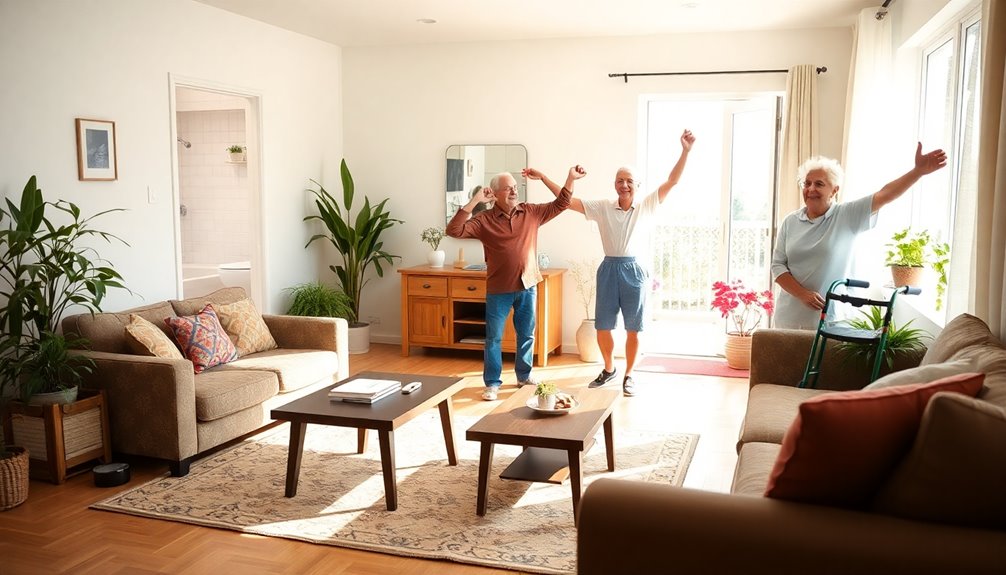
Staying active is essential for reducing your risk of falls at home. Engaging in regular physical activity, like walking, tai chi, or strength training, boosts muscle strength and enhances balance and mobility. This not only reduces the risk of falls but also improves your overall health. Aim for at least 150 minutes of moderate-intensity aerobic activity each week. Consider joining group exercise programs at senior centers for social interaction and safe movement. Additionally, maintaining safe sleep practices can contribute to overall well-being, which is crucial for preventing falls.
| Activity Type | Benefits | Frequency |
|---|---|---|
| Walking | Improves endurance | Daily |
| Tai Chi | Enhances balance | 2-3 times/week |
| Strength Training | Builds muscle strength | 2-3 times/week |
| Pilates | Increases flexibility | 1-2 times/week |
| Dancing | Fun & social activity | 1-2 times/week |
Wear Sensible Shoes
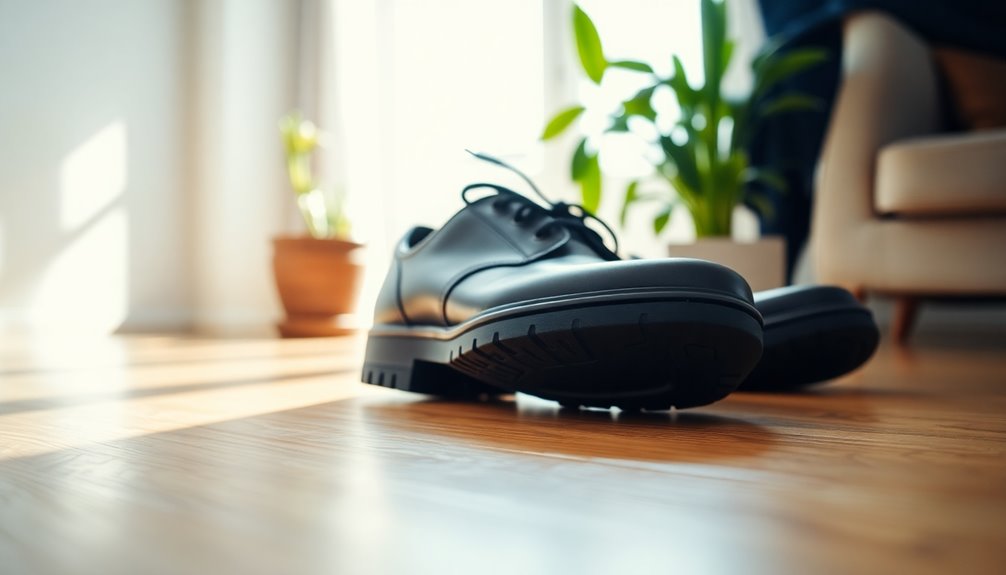
Wearing sensible shoes is essential for your safety at home.
Choose footwear with non-slip soles and make sure they fit well to maintain balance and stability.
Avoid high heels and other unstable options that can increase your risk of falls.
Choose Non-Slip Soles
Choosing shoes with non-slip soles can greatly enhance your safety at home, as they considerably reduce the risk of slipping and falling on wet or uneven surfaces.
When you choose sensible footwear, you're not just prioritizing style; you're investing in your stability and balance. Avoid high heels, floppy slippers, and shoes with slick soles, as these can increase your risk of tripping.
Regularly check your shoes for wear and tear, and replace them when the soles show significant signs of damage. By wearing non-slip soles, you can effectively prevent falls and promote overall mobility.
Sensible footwear not only keeps you safe but can also help alleviate joint pain, contributing to a more comfortable and secure home environment. Additionally, integrating smart home devices can further enhance safety by providing alerts for potential hazards in your living space.
Ensure Proper Fit
Finding shoes that fit well is just as important as selecting non-slip soles. Properly fitting shoes provide the sturdy construction and support you need to reduce the risk of falls at home, especially if you're a senior.
Choose sensible shoes that offer non-slip soles and proper support to enhance your stability while walking. Avoid high heels, floppy slippers, and shoes with slick soles, as they can lead to tripping and slipping hazards.
Regularly inspect your shoes for wear and tear; worn-out soles can seriously compromise your traction.
Avoid High Heels
High heels may look stylish, but they can seriously compromise your balance and increase your risk of falls at home.
To maintain your independence and reduce the fear of falling, it's essential to avoid high heels. Instead, opt for proper footwear that offers:
- Stability – Choose shoes with a wider base for better support.
- Nonslip Soles – Look for shoes with nonslip features to enhance traction on various surfaces.
- Proper Fit – Verify your shoes fit well to avoid blisters and discomfort, which can lead to falls in older adults.
- Sturdy Construction – Select shoes that provide adequate support for your feet and ankles.
Additionally, maintaining a healthy weight can further improve balance and stability, reducing the risk of falls.
Remove Home Hazards
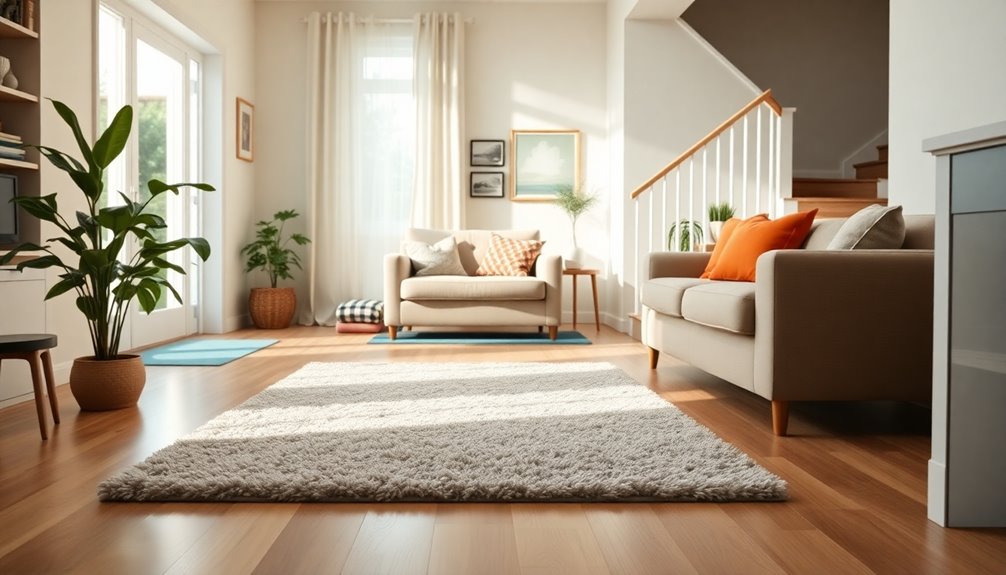
To reduce your risk of falls at home, start by clearing walkways of clutter and securing loose rugs.
Removing tripping hazards like boxes and newspapers makes a big difference in keeping your space safe.
Regularly checking your floors will help guarantee you avoid any dangerous slips or trips. Additionally, maintaining a clean and organized environment can significantly contribute to minimizing fall risks.
Clear Walkways Regularly
One of the simplest yet most effective ways to reduce the risk of falls at home is to regularly clear your walkways.
Keeping your space tidy not only looks good but also minimizes tripping hazards. Here are some tips to help you keep those walkways clear:
- Remove clutter like boxes and newspapers that can obstruct your path.
- Secure electrical cords along walls to prevent snagging.
- Arrange furniture to create clear travel corridors, especially in high-traffic areas.
- Store frequently used items within easy reach to avoid unnecessary bending or stretching.
Additionally, maintaining a clear path can help improve overall mobility and prevent accidents.
Secure Loose Rugs
Although they can add warmth and style to your home, loose rugs pose a serious tripping hazard, especially for seniors. To reduce fall risks, it's crucial to secure loose rugs using double-sided tape or non-slip rug pads.
These solutions keep rugs in place, preventing them from shifting or bunching up. If securing rugs isn't practical, consider removing them from high-traffic areas altogether.
Regularly inspect your rugs for wear and tear, as frayed edges can increase the likelihood of tripping. Opting for rugs with non-slip backing or using carpet tiles can also enhance stability.
Remove Clutter Promptly
When you keep hallways and living areas free of clutter, you greatly lower the risk of falls in your home.
To maintain a safe environment, make sure to remove clutter promptly and reduce the likelihood of accidents, especially for elderly adults.
Here are four tips to help you achieve this:
- Clear pathways: Remove magazines, toys, and boxes that can obstruct movement.
- Store smart: Keep frequently used items at waist level to avoid bending or stretching.
- Secure rugs: Use double-faced tape to prevent slipping.
- Inspect regularly: Check for loose floorboards or carpets and repair them quickly.
Light up Your Living Space
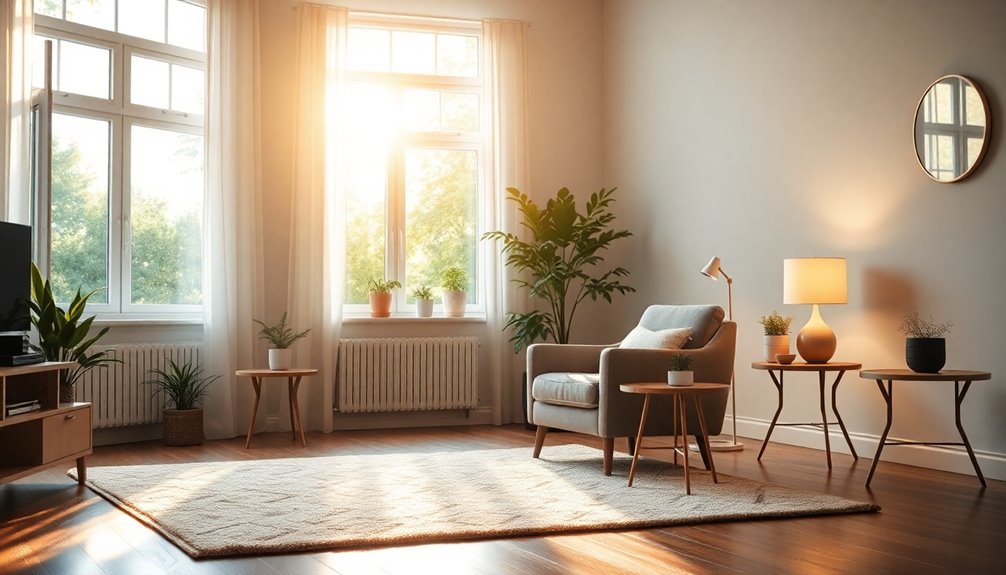
Brightening your living space is essential for reducing the risk of falls at home. Make certain all areas, especially hallways and stairways, are brightly lit to enhance visibility and minimize shadows that can obscure hazards.
Install night lights in bedrooms and bathrooms for safe navigation during nighttime, helping prevent falls in the dark. Regularly replace burnt-out bulbs and choose brighter, energy-efficient lighting to improve illumination.
Avoid dimly lit areas by using light-colored paint for walls, which can further aid in fall prevention. Finally, keep paths to light switches clear and accessible, so you can easily turn on lights before entering potentially hazardous spaces. Additionally, consider using air purifiers to enhance overall indoor air quality, which can contribute to better visibility and safety in your home.
Use Assistive Devices
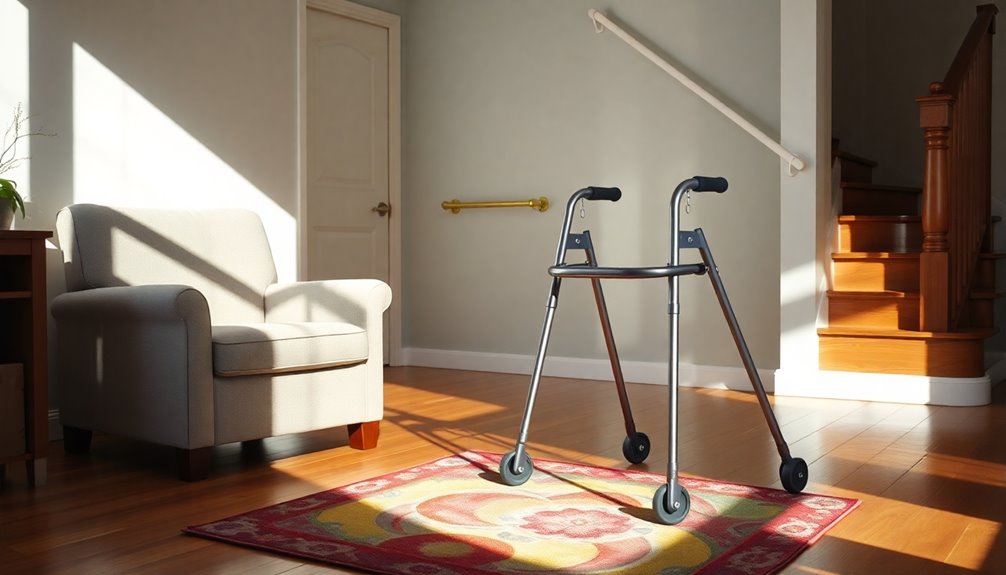
Using assistive devices can greatly enhance your safety at home, especially if you have balance issues or mobility limitations. These tools provide essential support to reduce the likelihood of falls.
Here are some key options to take into account:
- Canes and Walkers: They improve stability for individuals with mobility impairments.
- Handrails and Grab Bars: Install these on both sides of stairways and in bathrooms for vital support during transfers.
- Hip Protectors: These can lessen the severity of injuries from falls, offering extra protection.
- Regular Maintenance: Verify assistive devices are properly fitted and well-maintained for peak safety.
Incorporating these assistive devices into your daily routine can greatly enhance your balance and overall safety at home.
Manage Your Health to Reduce Falls Risk
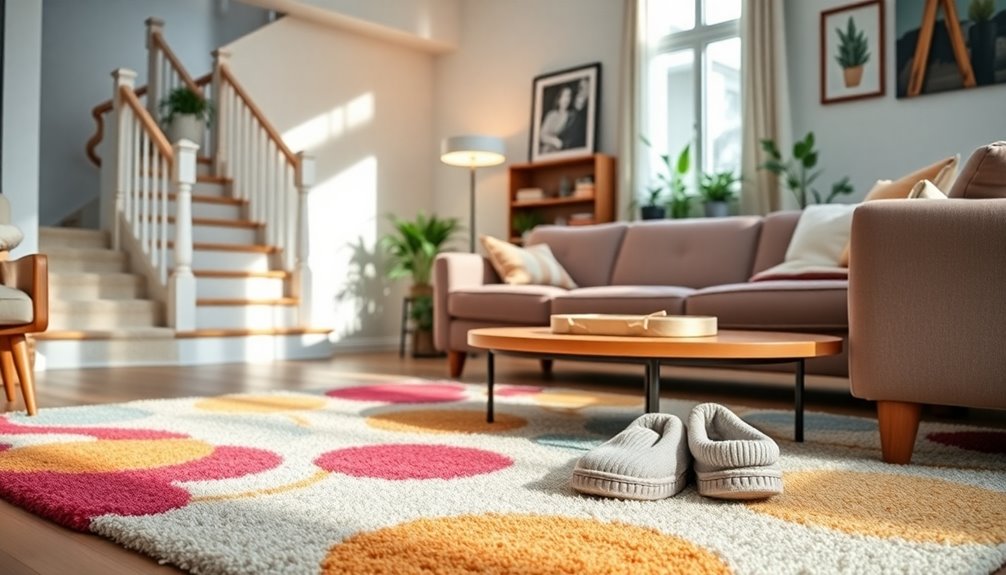
Managing your health is essential for reducing the risk of falls at home. Regular health monitoring helps you stay aware of chronic conditions like Parkinson's disease, heart failure, and arthritis, which can increase fall risk.
It's also important to review your medications with healthcare providers, as polypharmacy can lead to dizziness and balance issues. Schedule regular physical examinations to assess your gait and vision—key factors in preventing falls.
Additionally, maintain a balanced diet rich in calcium and vitamin D to support bone health and reduce joint problems. Turmeric's potent relief may also help manage arthritis symptoms, further decreasing the likelihood of falls. Avoid smoking and limit alcohol intake; these lifestyle changes can greatly improve your overall health and further reduce the likelihood of falls and fractures.
Frequently Asked Questions
How Can You Reduce the Risk of Falling at Home?
To reduce the risk of falling at home, you should keep your living space well-lit, especially in key areas like stairways and bathrooms.
Clear clutter from floors and hallways, and consider installing grab bars and handrails for added support.
Wear properly fitting, non-slip shoes to improve your footing.
Finally, review your medications with your healthcare provider to avoid dizziness and balance issues that could lead to falls.
What Are the 5 P's of Falls Prevention?
The 5 P's of fall prevention are essential for maintaining safety at home.
First, you need to Prevent hazards like clutter and loose rugs.
Then, Prepare by ensuring well-lit spaces, especially stairs and bathrooms.
Next, Personalize your approach based on your health and medications.
Practice regular physical activities to boost balance and strength.
Finally, Participate in healthcare appointments to keep track of your health and vision, which can help reduce fall risks.
What Are Fall Safety Tips for the Home?
To enhance fall safety at home, you should focus on several key areas.
First, make certain all spaces are well-lit, especially hallways and stairways.
Keep floors clear of clutter to avoid tripping hazards.
Install grab bars in bathrooms and handrails on stairways for added support.
Wear sturdy shoes with non-slip soles.
Finally, regularly check that safety features like grab bars are secure and mats are in good condition to maintain a safe environment.
What Are the 6 P's of Fall Prevention?
The 6 P's of fall prevention are vital for maintaining your safety.
Focus on Posture to stay balanced and upright.
Address any Pain that might affect your mobility.
Create a solid Plan by removing hazards in your environment.
Don't hesitate to ask for Permissions if you need help; knowing your limits is essential.
Regular Practice through physical activity can boost your strength and balance, while proper Position guarantees safe movement techniques are used.
Conclusion
In the garden of life, keeping falls at bay is like nurturing a delicate flower. By tending to your health, pruning hazards, and illuminating your path, you cultivate a safer home. Don't forget to wear sturdy shoes, just as a gardener wears gloves, to protect yourself from slips and tumbles. With these expert tips, you're not just avoiding falls; you're creating a vibrant, flourishing sanctuary where you can thrive without fear. So, let's grow wisely!
